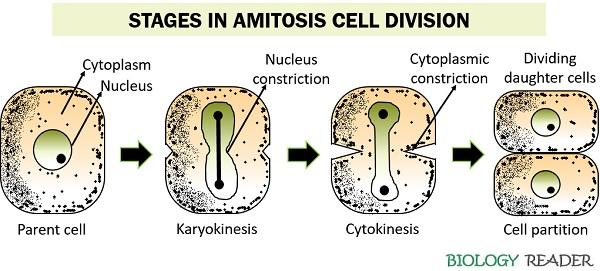Amitosis cell division is a form of direct cell multiplication where the nuclear and cytoplasmic contents of parent cell split between the two daughter cells via a simple cell constriction. It is a kind of growth and multiplication process that predominantly occurs in the acellular or unicellular organisms such as algae, bacteria, cyanobacteria, protozoans and yeasts.
The cytokinesis (cytoplasmic division) begins after the karyokinesis (nuclear division) due to deepening in the cell furrow during amitosis. Thus, amitosis is a kind of asexual growth and multiplication that does not involve events like chromatin condensation, chromatid separation, spindle formation etc. Remark and Kolliker were the two scientists who described the karyokinesis and cytokinesis.
Schleicher proposed a term karyokinesis and Whitman introduced term cytokinesis. A scientist named Robert Remak was the first to describe amitosis, and W. Flemming coined the term. We will discuss the meaning, examples, characteristic features, mechanism, significance, and drawback of the amitosis cell division in this context.
Content: Amitosis Cell Division
Meaning of Amitosis
Amitosis is a type of direct cell division where a simple cell constriction partitions the nucleus and cytoplasmic content that eventually causes the splitting of a parent cell into two nascent cells. Firstly, a nucleus division occurs followed by cytoplasmic division during amitosis, like other cell divisions (mitosis and meiosis). The process of amitosis is characterized by the formation of cleavage furrow or cell constriction. In microbes, amitosis usually occurs horizontally or vertically.

Amitosis involves DNA replication and splitting of the cell. It is a primitive type of cell division where a simple mass division of a pre-existing cell occurs. A parent cell does not go through the stages like prophase, metaphase, anaphase and telophase, unlike mitosis. In amitosis, a nucleus fo through segmentation or septum formation.
Examples of Amitosis
Amitosis cell division is carried out by many organisms and eukaryotic cells that are mentioned below:
- It predominantly exists in the unicellular organisms like algae, protozoans and bacteria.
- Amitosis is also carried out by the acellular group of fungi, i.e. yeast cells.
- It also occurs in the eukaryotic cells like cartilage cells, foetal cells and extra-embryonic cells.
- In plants, amitosis can be seen in the endosperm cells of the seed.
- Besides, diseased, degenerating and old cells also show the amitotic type of cell division.
Identifying Features
The process of amitosis is characterized by the following features:
- The spindle fibres formation cannot be observed in the amitosis cell division.
- There is no chromatin condensation.
- The chromosomes do not appear as chromatids or remain despiralized.
- Centromeres are not distinctly seen.
- Chromatin fibre does not replicate.
- The nuclear membrane and nucleolus appear or remain intact during the cell division, unlike the mitotic and meiotic cell division.
- A parent cell forms two daughter cells directly through the deepening of cell furrow.
- It facilitates a random or unequal distribution of the parental chromosomes.
Mechanism of Amitosis Cell Division
Amitosis is a cellular division that occurs without any nuclear events or involves a simple mass division of a pre-existing cell via centripetal cell constriction. The events or stages of amitosis can be summarized as follows:

- Firstly, the nucleus of a pre-existing or a parent cell will elongate longitudinally.
- A nucleus assumes a dumbbell shape.
- After that, DNA duplication takes place within the nucleus.
- Ultimately, a nucleus partitions into two nuclei.
- Then, the cytoplasm constricts centripetally.
- The cytoplasmic constriction gradually increases or deepens continuously inward to the cell.
- Eventually, parent cell partitions into two halves.
Significance
Amitosis is a cellular division that is pre-requisite for the acellular organisms to continue their lives. A cellular division is crucial for producing new cells and bodies and replacing the old and damaged cells. A dividing cell is called a parent or pre-existing cell, and the individuals formed after the fission of a parental cell are called daughter cells or nascent cells. Here, the cell primarily involves DNA duplication and splitting. A parent cell splits into two halves after the DNA is duplicated within the nucleus. It is crucial for the evolution of new species and regeneration of the cells.
Drawback
Amitosis is known as direct cellular fission, in which a cell splits into two halves directly via centripetal constriction of the cell-wall. As no nuclear events occur, there will be an unequal distribution of the chromatin material between the two developing cells. As a result, certain abnormalities in the growth and metabolism can be seen in the individuals produced through amitosis.
Conclusion
We can conclude that an amitosis is a primitive form of a cell division, which is more likely to be the asexual binary fission. Here, a cell directly splits into two individuals by following the nucleus and cytoplasmic division.
Everything is clear. Thank you very much